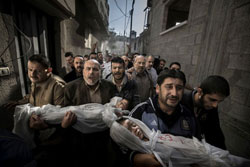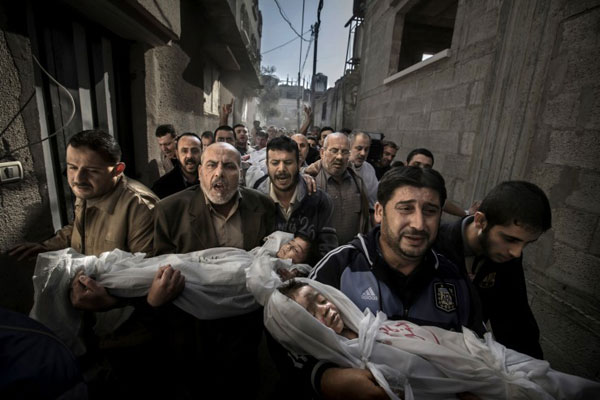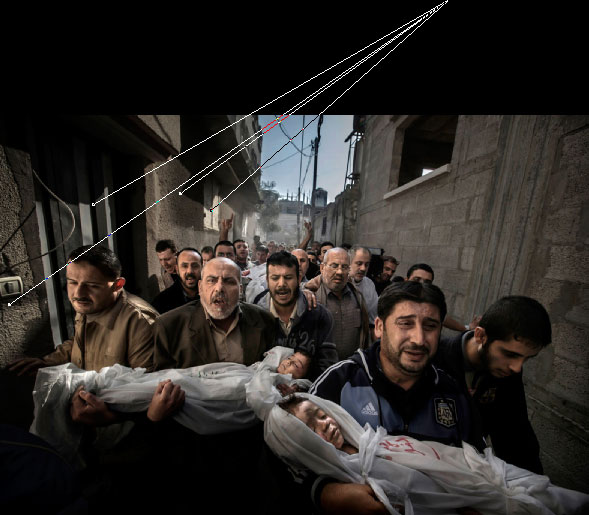Was winning photo faked with Photoshop? World Press Photo launches probe (UPDATED)
posted Tuesday, May 14, 2013 at 11:19 AM EDT

World Press Photo announced this morning it has asked two independent experts to "carry out a forensic investigation" of the winning image in its 2012 World Press Photo of the Year contest. The image, a shot by Swedish photographer Paul Hansen of a Palestinian funeral procession, has come under fire for being allegedly excessively enhanced via photography software.
"The photograph by Paul Hansen, which has been selected as World Press Photo of the Year 2012 by the contest jury, has been subject to heated discussion about the level of enhancement of the image file," World Press Photo said in a statement. "Paul Hansen has previously explained in detail how he processed the image. World Press Photo has no reason to doubt his explanation. However, in order to curtail further speculation - and with full cooperation by Paul Hansen - we have asked two independent experts to carry out a forensic investigation of the image file. The results will be announced as soon as they become available."
UPDATE: World Press Photo has just posted statements from the indepedent experts confirming "the integrity of Paul Hansen's image files." The statements, from Dr. Hany Farid, Professor of Computer Science at Dartmouth College and co-founder and CTO of Fourandsix Technologies and Kevin Connor, CEO of Fourandsix Technologies; along with Eduard de Kam, digital photography expert NIDF (Nederlands Instituut voor Digitale Fotografie), can be read here.
This latest news comes on the heels of a separate analysis from another forensic image expert who claims Hansen's winning shot is actually a composite of three images. That forensic image analyst, Neal Krawetz, says the winning photo includes spliced together areas of three different shots, which was done to illuminate the faces of the mourners in the picture in order to make the scene more dramatic.

In a blog post about the photo, Krawetz says one of the things that struck him about Hansen's winning image, called "Gaza Burial," was how the shadows didn't appear to line up for the time of day it was shot. The photo was captured at 10:40am on November 20, 2012 in Gaza City shortly after an Israeli missile hit the area.
"The shadows from the left wall line up with a consistent sun location. The sun isn't exactly low but maybe the reported time is wrong. At least the sky brightens in the direction of the sun. Unfortunately, the lighting on the people does not match the sun's position. The people should have dark shadows on their right sides (photo-left), but their facial lighting does not match the available lighting," Krawetz wrote in his post.
"So here's what likely happened... The photographer took a series of photos. However, the sun's position made everyone dark and in silhouette. So, he combined a few pictures and altered the people so you could see their faces."

As evidence, Krawetz says he looked at the image's Phoshop save history which, he claims, shows that two additional Raw images were added to the original shot on January 4, 2013, which was a few weeks before the World Press Photo's 2012 contest deadline.
There's much more detail on Krawetz's image analysis on his blog.
UPDATE: The statements from Farid and Connor of Fourandsix Technologies just posted on the World Press Photo site, question the accuracy of Krawetz's claims.
“We have reviewed the RAW image, as supplied by World Press Photo, and the resulting published JPEG image. It is clear that the published photo was retouched with respect to both global and local color and tone. Beyond this, however, we find no evidence of significant photo manipulation or compositing," Farid and Connor wrote. "Furthermore, the analysis purporting photo manipulation is deeply flawed, as described briefly below.”
To read Farid and Connor's point-by-point questioning of Krawetz' argument, click here.
Krawetz' blog post led to a biting article on Extreme Tech titled "How the 2013 World Press Photo of the Year was faked with Photoshop." And just last week, Spiegel discussed the possibility that Hansen's winning image might have been digitally enhanced in a much shared story called "Enchanced Reality: Exploring the Boundaries of Photo Editing."
Meanwhile, Hansen has defended his image, telling news.com.au, that the "photograph is certainly not a composite or a fake."
"I have never had a photograph more thoroughly examined, by four experts and different photo-juries all over the world," he said.
Hansen goes on to tell news.com.au that he was able to get the dramatic lighting on the mourners faces by developing the "raw file with a different density to use the natural light instead of dodging and burning. In effect to recreate what the eye sees and get a larger dynamic range."
"To put it simply, it's the same file - developed over itself -- the same thing you did with negatives when you scanned them."
The World Press Photo contest rules are fairly explicit when it comes to image manipulation, stating that the "content of the image must not be altered. Only retouching which conforms to the currently accepted standards in the industry is allowed.”